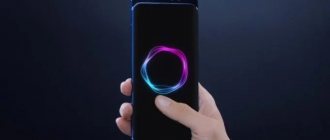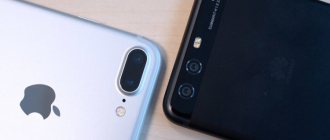Operating principle
The operating principle of wireless charging is electromagnetic induction. This means that any gadget cannot be charged this way: it must have a magnetic coil connected to the battery. Usually it is hidden under the housing cover, thin and invisible to the eye. It is possible to install an induction module on any smartphone, and then the question of which phones can be charged wirelessly disappears. But this is not so convenient, since it takes up the USB port and makes the device larger.
Those smartphones and chargers that are equipped with the function support the Qi standard. The word is read as “Qi”, it means the energy of the surrounding world in Chinese culture. Many lines of smartphones already support the technology: iPhone from version 8, Samsung, LG, Nokia, Xiaomi and other brands. I have compiled a small “rating” - which phones support wireless charging in different price segments, which I will share below.
What is the Qi standard
This is a standard that was developed by the Wireless Electromagnetic Energy Consortium. As they said earlier, the idea of transmitting electricity over distances is as old as the world; a striking example is the idea of Nikola Tesla. But two centuries ago, Ampere deduced the law. From it it is clear that electric current is capable of creating a magnetic field. This phenomenon is used in many fields of technology (generators, motors, sensors).
Scientists around the world have been working on the problem of transmitting electricity over distance, but large manufacturers only began to take an interest in this topic in 2009. That's when the Qi standard was created. It can be used in any handheld devices - smartphones, e-readers, tablets. Gadget manufacturers have begun to introduce wireless charging functionality into their devices. And the main advantage is that the Qi standard is available to everyone, and you don’t have to pay for it.
For this reason, manufacturers have been trying to introduce this function into their gadgets for 10 years. It’s just that it’s presented as something elite and can only be found on expensive smartphones, although the price of the receiver and docking station is actually low. After all, there are no super-complex and expensive innovations in the Qi standard. It consists of generating an electromagnetic field and converting it back into electricity.
For new smartphones, wireless charging is a feature that is already included in the basic package. Expensive phone models can be charged this way. You are unlikely to find wireless charging functionality in budget models. But they sell wireless charging kits that allow you to upgrade a cheap smartphone. And the cost of modernization is not very high.
Phones with wireless charging: what to look for when choosing
The charger itself and the smartphone can be of different manufacturers, colors and designs. The most important thing that should match is support for the Qi standard. Any phone with this option can be charged on any Qi charger. The main thing is that the distance between devices is minimal – up to 5 cm.
Phones that support wireless charging have many advantages:
- No need for phone wires: as a result, increased service life of the USB port. Now in new models it is also used as an audio output, so this is doubly important.
- Extended battery life. The battery and wireless charger have a connection through which they exchange data. When fully charged, the device turns off, which has a positive effect on both the smartphone and the overall electricity consumption.
- Appearance. Qi devices are stylish and compact. The wires that are connected to them are easy to hide. It's much more aesthetically pleasing than regular wired charging.
How do you know if your smartphone supports wireless charging?
It is impossible to visually determine the presence of this option on the phone. When placed on an inductive charger, the mobile device receives energy wirelessly through an induction coil (don’t get confused now), which is placed on the non-removable back cover of the smartphone.
1. In most cases, you will not find information about Qi support on the phone itself. 2. Wireless charging is also not mentioned in the smartphone settings (write in the comments if the manufacturer has added information in your case). 3. The only way (besides connecting) is to find out the characteristics from the documentation or through services.
The surest way to determine whether your phone supports wireless charging is to refer to the documentation and specifications in it. But you can also find your device in aggregator systems for verification.
To find out if your smartphone has wireless charging, you don’t need to disassemble it - just check the name in the WPC consortium or on one of the four services.
Wireless charging phones: top tips
So, when you become the proud owner of a wireless charger and a phone suitable for it, you should pay attention to the following points:
- The phone must be accurately positioned on the charger. It should not move, otherwise it may not charge when displaced.
- The process takes longer than normal charging.
- No confirmed negative impact on the phone battery has been identified. On the contrary, monitoring the charge level extends the life of the battery.
- There is no and cannot be an impact on human health: non-ionizing radiation is used.
New smartphone models with wireless charging appear every day. Now these are not only flagships, but also quite budget devices. The trend is that there will be more and more of them. Already now you can choose a suitable device from the rating I compiled in order to fully experience all the benefits of living without wires.
Compare the best models!
To make it easier for you to choose the right wireless charging model, we recommend that you familiarize yourself with the comparative table, which shows the main technical characteristics of the most popular models.
| Model name | Price, rubles | Power, W) | Interface |
| DEXP Q5 | 300 | 5 | QI |
| Qcyber Mobile QI QM-05-001 DV01 | 380 | 5 | QI |
| Red Line YT000013569 | 700 | 6 | QI |
| Spigen Essential F301W 10W | 1 100 | 5 | QI, Quick Charge |
| DEXP ICY-W001 | 1 200 | 10 | QI, USB Type-C |
| Nillkin Magnetic Wireless Charger Car II | 1 300 | 5 | QI |
| HOCO CW10 Elegant | 1 500 | 10 | QI |
| Samsung EP-NG 930BWRGRU | 2 000 | 12 | USB Type-C, QI |
| Deppa QI Fast Carger | 2 300 | 10 | QI, USB, Quick Charge |
| Belkin BoostUp Wireless Charging Pad | 2 500 | 7.5 | QI, Quick Charge |
| Mophie Wireless Charging Base | 2 800 | 18 | QI, USB |
| Mi Wireless Charger | 3 000 | 5 | USB Type-C, QI |
| Samsung EP-PG950B Convertible | 3 700 | 5 | QI, Quick Charge |
| Samsung EP-N5100BBRGRU | 4 900 | 9 | QI, Quick Charge |
| Belkin QI F7U027vfWHT | 6 100 | 7.5 | QI, USB Type-C |
TOP 9: Wireless charger COTEetCI – 2,200 rubles
Characteristics
How wireless charging works
COTEetCI is a powerful charger in a compact case. The diameter of the device is only 70 mm, which is slightly less than the width of a smartphone and slightly larger than an Apple Watch. Moreover, this “baby” can simultaneously charge both of these devices at the same time. And it won’t even refuse to connect to an Android device.
Stylish ultra-thin charger for mobile devices that support QI wireless charging technology. The wide platform allows you to comfortably place a smartphone and smart watch from Apple. The charger is suitable for communicators based on iOS and Android, providing each device with its own output power.
Important! So for Apple phones the maximum power will be 7.5 W, and for Android - 10 W. The watch will be charged with a power of 3 W
Made from durable and lightweight ABS plastic. It has a rubberized platform that will not damage the body of the charged devices. The charging base is equipped with silicone feet that prevent the platform from sliding on the surface. The model is lightweight and compact in size, its thickness does not exceed 1 cm, which allows you to take the charger with you on the road.
Peculiarities
- Ergonomic design
- Thickness 10 mm
- Wireless charging type
- Replenishing energy for two devices at once
- Suitable for Apple Watch and iOS and Android smartphones
- Each device has its own power
What should you consider when purchasing?
Buying a wireless charger is a little more complicated than buying a traditional charger. In order not to make a mistake with your choice, you should take into account several criteria that will ensure high efficiency and comfort of using the device.
The main parameters that you should pay attention to when purchasing are the following:
- Coil power level: for most manufacturers this criterion is in the range of 5-20 watts. The speed of charging the battery will depend on the power.
- Availability of a cooling function: to prevent the device from breaking down prematurely, it is highly advisable to buy a model with a cooling function (built-in cooler). During the charging process, not only the smartphone itself heats up, but also the charger on which it is installed.
- Additional features: Additional communication ports, such as USB ports, will help improve the comfort of use.
Naturally, the presence of additional functions and capabilities will affect the cost of the gadget. If you want to buy a truly high-quality charger that will serve you for many years, then you should not save.
Types of wireless chargers
Having become familiar with the advantages and disadvantages of chargers that exclude the use of wires, many users have an active desire, despite the high cost, to still become its owner.
Currently, manufacturers are ready to offer several options for such devices, so before making a purchase, it is useful to understand their distinctive features in order to understand which model can rightfully be considered the best.
Popular chargers
The Samsung company, accustomed to surprising consumers with interesting smartphones, has not ignored the issue of creating a wireless charger. The result of the company's work on such a technical problem is the Samsung Wireless Charging Pad device.
Many users welcome it because it allows you to charge your smartphone, which can be in any position relative to the top surface of the charger itself.
Samsung Wireless Charging Pad provides charging for smartphones that support not only the WPC standard, but AW4P and PMA.
Another device that is highly popular is the PowerBot. It is welcomed by the consumer because:
- it itself can be connected not only to the mains, but also to a laptop;
- has an acceptable cost;
- accompanied by a high level of reliability;
- The manufacturer guarantees a long operational period.
Another wireless device, Nokia DT-910, provides fast charging for smartphones. In addition, the manufacturer has endowed it with many additional and very useful functions; anyone who owns such a device will be able to understand them.
So, you can easily find and, if desired, purchase a wireless charger of a certain type in the retail network. Since there is no risk to health during further use of such a product, if you have the appropriate amount, you can purchase such a device in order to subsequently allow yourself to expand the possibilities for recharging your smartphone.
How to make a wireless phone charger with your own hands
DIY induction charger Materials and tools
First, let's see what materials we need to build a homemade wireless charger for a smartphone with our own hands:
- A piece of board. Not very large, but sufficient to place the rest of the elements on it;
- Film capacitor. Its minimum capacity should be 0.33 μF, maximum - 1 μF;
- Throttle. It should have from 5 to 10 turns. Wire diameter - approximately 1 mm;
- Two UF type diodes;
- 2 resistors with a rating of up to 1 Watt;
- Two field-effect high-voltage transistors. The voltage must be at least 10 Volts;
- Solder;
- Soldering iron.
What does a traditional charger consist of?
Before making a charger with your own hands, let's look at what it consists of and how it works. There is a box (board) on which we will make a generator. A transmission circuit is connected to it. It affects the receiving circuit. A high-frequency field appears on the primary circuit. This voltage is transmitted by induction to the secondary circuit. There it is straightened and smoothed by a capacitor, then stabilized to 5 Volts in the stabilization unit.
Making a transmitter (generator) with your own hands: description of the circuit
To begin with, here is a diagram of a wireless phone charger that we will make with our own hands.
The transmitting circuit has two half-windings, which are connected to the middle point. The middle point goes through the inductor to the power supply plus. Limiting resistors that go to the bases of the transistors are also connected to the power supply plus. The diode goes from the base of one transistor to the collector of the opposite transistor. The same with the second diode.
The collector goes to the ends of the winding. For DIY construction there is an option without a midpoint. To do this, you need to take two chokes, parallel one of the terminals of each inductor and connect it to the power supply positive. Disconnect the free leads to the collectors of each transistor. You can assemble this option with your own hands, but the elements will get very hot.
Power depends on the elements used. A device made according to this scheme can be made both weaker and stronger. Using this scheme, you can construct a 2-amp wireless charger with your own hands.
Making your own reel
First, let's wind the outline with our own hands. It doesn't have to be very neat. You can use a piece of plastic with a diameter of 5-10 cm or your fingers.
We take one long wire. Fold it in half. Straighten it.
We wrap 5 turns on fingers or plastic.
Now we secure the coils themselves around the entire circumference with glue or tape.
We are left with three tips. One with a fold. Cut off this fold. Now we have 4 tips. We clean them.
We will need to connect either the end of the first winding to the beginning of the second, or the beginning of the first winding to the end of the second. To check what is connected to what, we use a multimeter.
Set the multimeter to diode test mode. We connect the multimeter to each tip at both ends simultaneously. We see that when connected to some ends the multimeter reacts, but when connected to others it does not. These tips should be on different sides. We must twist them together and solder them. This is the middle point. The remaining tips are two collector windings that go to the transistors. Now we are ready to assemble the charger ourselves.
Putting it all together with our own hands
To assemble the device with your own hands, we take solder, a soldering iron and a circuit board. First we solder two transistors.
After this we solder the diodes.
These include resistors. One tip goes to the diodes, the other to the board.
Now we solder the circuit with our own hands. We wound it up earlier. Now you need to tin its two windings and connect them to the circuit.
Receiver
As a rule, people don’t dare to make a wireless charging receiver with their own hands, since here you already need to get into the phone. A rather crude separate receiver can be made with your own hands just to check if the transmitter works. In a DIY receiver, it is advisable to use a UF diode as well.
Capacitor with a capacity of 47-100 µF. Operating voltage: 25 volts. The second capacitor can be used for 10-16 Volts. Capacity - 47 µF. The circuit of the receiver, made by hand, is also 10 turns. Wire diameter - 0.75 mm.
It is more difficult to understand the written instructions than to follow the actions shown. We have attached a video on how to make a wireless phone charger with your own hands.
Honor 10 wireless charging capability
To the displeasure of many owners of the tenth model, it does not support the function of recharging the battery wirelessly. This may be due to the fact that the introduction of such technology would lead to an increase in the cost of the device. The manufacturer did not install standard equipment for receiving energy in the Honor 10I and 10 Light modifications.
A survey was conducted among potential buyers of the device about the need to introduce wireless charging. More than half would welcome such an opportunity. But there was also an opinion that it would be better to increase the battery capacity - then the smartphone would have to be charged less often.
Wireless charging – what is it and how does it work?
The very name “wireless charging” defines its main function - the ability to charge the battery of an electronic device without connecting to an energy source through connecting wires. To charge your smartphone, you just need to place its back side on a special device, the DOCK station, after which the process occurs automatically. The operating principle of wireless charging is based on the use of electromagnetic induction. The DOK station creates an alternating magnetic field, and in the receiving device, in this case it is a smartphone, an induction coil is installed, which serves as a receiver of the energy created by this field.
To charge several electronic devices, special types of docking stations are used, equipped with several energy transmitters
The voltage created at the charging station is transmitted via electromagnetic waves to the “consumer” coil, where a potential difference is also created, and as a result, an electric current appears that flows in the power supply circuit of the smartphone battery.
Are there any alternatives to wireless charging?
A few years ago, information flashed here and there about a new development capable of wirelessly charging not only a smartphone, but also other devices. At the same time, she had to do this at the same time. The idea was to install a pillar in the center of the room that could create a large field. Objects located in this field could work without wires.
Considering that such a “breakthrough” invention never went into production, it’s worth thinking about why this happened. Most likely, the reasons included radiation hazardous to human health, significantly stronger than from the charging station, and high energy consumption.
On the second point, we can add that due to losses during the transfer of energy from the charger coil to the coil in the smartphone, electricity costs will increase. Considering small consumption, the difference will be several rubles per month. In larger installations, energy consumption will be significantly higher. Accordingly, losses at such distances will make you think about the feasibility of this idea.
Alternative to wireless charging - another wireless charging
There is no full-fledged alternative to wireless charging, but there are, so to speak, sub-alternatives. I'm talking about those cases when wireless charging is built into PowerBank, table lamps, cabinets and other furniture that can be bought even at IKEA. Only the price of such devices is often steep.
What is inductive charging
The operating principle of wireless charging is based on the phenomenon of electromagnetic induction, which we were taught about at school. For inductive charging, two devices must be equipped with special coils: transmitting and receiving.
When the charger is turned on, an electromagnetic field is generated around the transmitting coil. This is how an electrical charge accumulates around the station.
The smartphone is placed in this field and its receiver coil begins to receive this charge through induction. The energy is converted into electricity and sent to recharge the battery.










